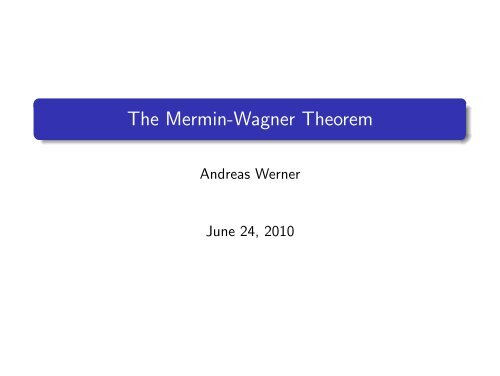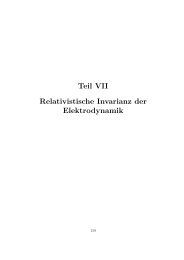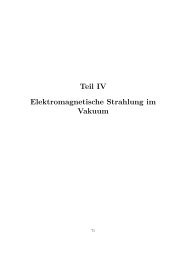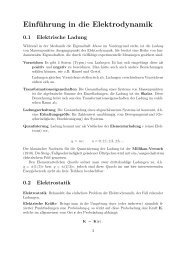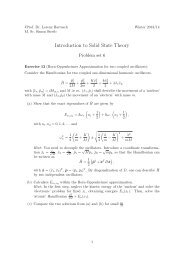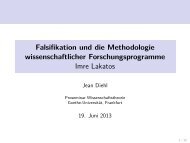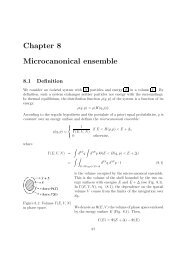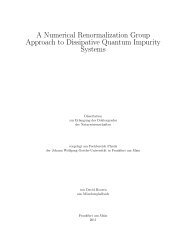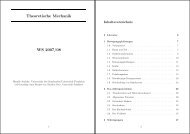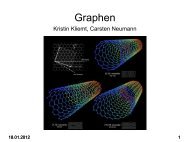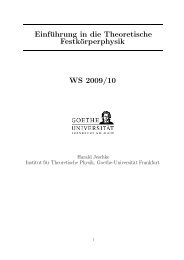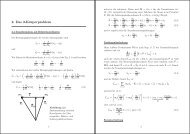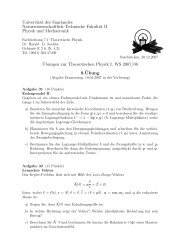The Mermin-Wagner Theorem - Condensed Matter Theory Group
The Mermin-Wagner Theorem - Condensed Matter Theory Group
The Mermin-Wagner Theorem - Condensed Matter Theory Group
Create successful ePaper yourself
Turn your PDF publications into a flip-book with our unique Google optimized e-Paper software.
<strong>The</strong> <strong>Mermin</strong>-<strong>Wagner</strong> <strong>The</strong>orem<br />
Andreas Werner<br />
June 24, 2010
How symmetry breaking occurs in principle<br />
Actors<br />
Proof of the <strong>Mermin</strong>-<strong>Wagner</strong> <strong>The</strong>orem<br />
Discussion<br />
Conclusion<br />
<strong>The</strong> <strong>Mermin</strong>-<strong>Wagner</strong> <strong>The</strong>orem<br />
In one and two dimensions, continuous symmetries cannot be<br />
spontaneously broken at finite temperature in systems with<br />
sufficiently short-range interactions.<br />
Andreas Werner <strong>The</strong> <strong>Mermin</strong>-<strong>Wagner</strong> <strong>The</strong>orem
How symmetry breaking occurs in principle<br />
Actors<br />
Proof of the <strong>Mermin</strong>-<strong>Wagner</strong> <strong>The</strong>orem<br />
Discussion<br />
Contents<br />
1 How symmetry breaking occurs in principle<br />
2 Actors<br />
3 Proof of the <strong>Mermin</strong>-<strong>Wagner</strong> <strong>The</strong>orem<br />
<strong>The</strong> Bogoliubov inequality<br />
<strong>The</strong> <strong>Mermin</strong>-<strong>Wagner</strong> <strong>The</strong>orem<br />
4 Discussion<br />
Andreas Werner <strong>The</strong> <strong>Mermin</strong>-<strong>Wagner</strong> <strong>The</strong>orem
How symmetry breaking occurs in principle<br />
Actors<br />
Proof of the <strong>Mermin</strong>-<strong>Wagner</strong> <strong>The</strong>orem<br />
Discussion<br />
For systems in statistical equilibrium the expectation value of an<br />
operator A is given by<br />
<br />
e −βH <br />
A<br />
〈A〉 = lim<br />
V →∞ tr<br />
If the Hamiltonian displays a continuous symmetry S it commutes<br />
with the generators Γi S of the corresponding symmetry group<br />
i<br />
H, ΓS = 0<br />
If some operator is not invariant under the transformations of S,<br />
i i<br />
B, ΓS = C = 0<br />
the average of the commutator C i vanishes:<br />
C i = 0<br />
−<br />
−<br />
Andreas Werner <strong>The</strong> <strong>Mermin</strong>-<strong>Wagner</strong> <strong>The</strong>orem
How symmetry breaking occurs in principle<br />
Actors<br />
Proof of the <strong>Mermin</strong>-<strong>Wagner</strong> <strong>The</strong>orem<br />
Discussion<br />
For systems in statistical equilibrium the expectation value of an<br />
operator A is given by<br />
<br />
e −βH <br />
A<br />
〈A〉 = lim<br />
V →∞ tr<br />
If the Hamiltonian displays a continuous symmetry S it commutes<br />
with the generators Γi S of the corresponding symmetry group<br />
i<br />
H, ΓS = 0<br />
If some operator is not invariant under the transformations of S,<br />
i i<br />
B, ΓS = C = 0<br />
the average of the commutator C i vanishes:<br />
C i = 0<br />
−<br />
−<br />
Andreas Werner <strong>The</strong> <strong>Mermin</strong>-<strong>Wagner</strong> <strong>The</strong>orem
How symmetry breaking occurs in principle<br />
Actors<br />
Proof of the <strong>Mermin</strong>-<strong>Wagner</strong> <strong>The</strong>orem<br />
Discussion<br />
It turns out that such averages may be unstable under an<br />
infinitesimal perturbation of the Hamiltonian<br />
one can define the quasi-average:<br />
Hν = H + νH ′ − µ ˆN<br />
〈A〉 q = lim<br />
ν→0 lim<br />
V →∞ tr<br />
<br />
e −βHν <br />
A<br />
<strong>The</strong> quasi-average does not need to coincide with the normal<br />
average<br />
i<br />
C <br />
= lim q ν→0 tr<br />
<br />
e −βHν H, Γ i <br />
S = 0 −<br />
Andreas Werner <strong>The</strong> <strong>Mermin</strong>-<strong>Wagner</strong> <strong>The</strong>orem
How symmetry breaking occurs in principle<br />
Actors<br />
Proof of the <strong>Mermin</strong>-<strong>Wagner</strong> <strong>The</strong>orem<br />
Discussion<br />
An Example:<br />
H = − <br />
ij<br />
JijSi · Sj<br />
it is invariant under rotations in spin-space<br />
[H, S] − = 0<br />
from S α , S β<br />
<br />
= 0 and [S<br />
−<br />
x , S y ] − = iS z<br />
we find that the conventional average of the magnetization<br />
vansihes.<br />
Adding a symmetry breaking field<br />
B0 = B0ez<br />
we may study quasi-averages and find spontaneous symmetry<br />
breaking.<br />
Andreas Werner <strong>The</strong> <strong>Mermin</strong>-<strong>Wagner</strong> <strong>The</strong>orem
David<br />
<strong>Mermin</strong><br />
(1935)<br />
How symmetry breaking occurs in principle<br />
Actors<br />
Proof of the <strong>Mermin</strong>-<strong>Wagner</strong> <strong>The</strong>orem<br />
Discussion<br />
Herbert<br />
<strong>Wagner</strong><br />
(1935)<br />
Pierre<br />
Hohenberg<br />
(1934)<br />
Sidney<br />
Coleman<br />
(1937-2007)<br />
Andreas Werner <strong>The</strong> <strong>Mermin</strong>-<strong>Wagner</strong> <strong>The</strong>orem<br />
Nikolai<br />
Bogoliubov<br />
(1909-1992)
How symmetry breaking occurs in principle<br />
Actors<br />
Proof of the <strong>Mermin</strong>-<strong>Wagner</strong> <strong>The</strong>orem<br />
Discussion<br />
<strong>The</strong> Bogoliubov inequality<br />
<strong>The</strong> <strong>Mermin</strong>-<strong>Wagner</strong> <strong>The</strong>orem<br />
For the proof of the <strong>Mermin</strong>-<strong>Wagner</strong> <strong>The</strong>orem we will use the<br />
Bogoliubov inequality<br />
1<br />
2 β<br />
A, A †<br />
[C, H] − , C<br />
+<br />
†<br />
<br />
≥<br />
−<br />
<br />
[C, A] 2 −<br />
Andreas Werner <strong>The</strong> <strong>Mermin</strong>-<strong>Wagner</strong> <strong>The</strong>orem
How symmetry breaking occurs in principle<br />
Actors<br />
Proof of the <strong>Mermin</strong>-<strong>Wagner</strong> <strong>The</strong>orem<br />
Discussion<br />
<strong>The</strong> Bogoliubov inequality<br />
<strong>The</strong> <strong>Mermin</strong>-<strong>Wagner</strong> <strong>The</strong>orem<br />
<strong>The</strong> idea for proofing the Bogoliubov inequality is to define an<br />
appropriate scalar product and then exploit the Schwarz inequality:<br />
with<br />
(A, B) = <br />
<br />
n<br />
A †<br />
<br />
<br />
m 〈m| B |n〉 Wm − Wn<br />
En − Em<br />
n=m<br />
Wn = e−βEn<br />
Tr (e −βH )<br />
A scalar product has four defining axioms:<br />
1<br />
(A, B) = (B, A) ∗<br />
This is valid since<br />
<br />
<br />
n<br />
B †<br />
<br />
<br />
∗ <br />
<br />
m 〈m| A |n〉 = n<br />
A †<br />
<br />
<br />
m 〈m| B |n〉<br />
Andreas Werner <strong>The</strong> <strong>Mermin</strong>-<strong>Wagner</strong> <strong>The</strong>orem
How symmetry breaking occurs in principle<br />
Actors<br />
Proof of the <strong>Mermin</strong>-<strong>Wagner</strong> <strong>The</strong>orem<br />
Discussion<br />
<strong>The</strong> Bogoliubov inequality<br />
<strong>The</strong> <strong>Mermin</strong>-<strong>Wagner</strong> <strong>The</strong>orem<br />
2 <strong>The</strong> linearity follows directly from the linearity of the matrix<br />
element<br />
3 It is also obvious that<br />
(A, A) ≥ 0<br />
4 From A = 0 it naturally follows that (A, A) = 0. <strong>The</strong> converse<br />
is not necessarily true<br />
In conclusion this shows that we have constructed a semidefinite<br />
scalar product.<br />
Andreas Werner <strong>The</strong> <strong>Mermin</strong>-<strong>Wagner</strong> <strong>The</strong>orem
How symmetry breaking occurs in principle<br />
Actors<br />
Proof of the <strong>Mermin</strong>-<strong>Wagner</strong> <strong>The</strong>orem<br />
Discussion<br />
<strong>The</strong> Bogoliubov inequality<br />
<strong>The</strong> <strong>Mermin</strong>-<strong>Wagner</strong> <strong>The</strong>orem<br />
To exploit the Schwarz inequality, we calculate the terms occurring<br />
in it:<br />
|(A, B)| 2 ≤ (A, A) (B, B)<br />
We now choose<br />
B =<br />
<br />
C † <br />
, H<br />
−<br />
Andreas Werner <strong>The</strong> <strong>Mermin</strong>-<strong>Wagner</strong> <strong>The</strong>orem
How symmetry breaking occurs in principle<br />
Actors<br />
Proof of the <strong>Mermin</strong>-<strong>Wagner</strong> <strong>The</strong>orem<br />
Discussion<br />
n=m<br />
<strong>The</strong> Bogoliubov inequality<br />
<strong>The</strong> <strong>Mermin</strong>-<strong>Wagner</strong> <strong>The</strong>orem<br />
First we calculate<br />
(A, B) = <br />
<br />
n<br />
A †<br />
<br />
<br />
m<br />
<br />
<br />
m<br />
C † <br />
, H<br />
−<br />
<br />
<br />
<br />
n <br />
Wm − Wn<br />
= <br />
<br />
n<br />
A †<br />
<br />
<br />
m m<br />
C †<br />
<br />
<br />
n (Wm − Wn)<br />
n,m<br />
= <br />
=<br />
m<br />
Wm<br />
Substituting B = C † , H <br />
<br />
<br />
m<br />
C † A †<br />
<br />
<br />
m − <br />
<br />
C † A † − A † C †<br />
=<br />
(B, B) =<br />
−<br />
, we find<br />
n<br />
Wn<br />
<br />
C † , A †<br />
−<br />
C † <br />
, [H, C] −<br />
−<br />
<br />
≥ 0<br />
Andreas Werner <strong>The</strong> <strong>Mermin</strong>-<strong>Wagner</strong> <strong>The</strong>orem<br />
En − Em<br />
<br />
<br />
n<br />
A † C †<br />
<br />
<br />
n
How symmetry breaking occurs in principle<br />
Actors<br />
Proof of the <strong>Mermin</strong>-<strong>Wagner</strong> <strong>The</strong>orem<br />
Discussion<br />
<strong>The</strong> Bogoliubov inequality<br />
<strong>The</strong> <strong>Mermin</strong>-<strong>Wagner</strong> <strong>The</strong>orem<br />
For (A, A) we use the following approximation:<br />
0 < Wm − Wn<br />
=<br />
En − Em<br />
<br />
Tr<br />
= Wm + Wn<br />
En − Em<br />
<br />
e −βH −1 e −βEm + e −βEn<br />
En − Em<br />
<br />
β<br />
tanh<br />
2 (En<br />
<br />
− Em)<br />
Since tanh x < x for x > 0, we find that<br />
0 < Wm − Wn<br />
En − Em<br />
< β<br />
2 (Wn + Wm)<br />
e−βEm − e−βEn e−βEm + e−βEn Andreas Werner <strong>The</strong> <strong>Mermin</strong>-<strong>Wagner</strong> <strong>The</strong>orem
How symmetry breaking occurs in principle<br />
Actors<br />
Proof of the <strong>Mermin</strong>-<strong>Wagner</strong> <strong>The</strong>orem<br />
Discussion<br />
We can now estimate the scalar product:<br />
(A, A) < β<br />
2<br />
≤ β<br />
2<br />
= β<br />
2<br />
This finally leads to<br />
<strong>The</strong> Bogoliubov inequality<br />
<strong>The</strong> <strong>Mermin</strong>-<strong>Wagner</strong> <strong>The</strong>orem<br />
<br />
<br />
n<br />
A †<br />
<br />
<br />
m 〈m| A |n〉 (Wn + Wm)<br />
n=m<br />
<br />
<br />
n<br />
A †<br />
<br />
<br />
m 〈m| A |n〉 (Wn + Wm)<br />
n,m<br />
<br />
n<br />
Wn<br />
<br />
<br />
n<br />
A † <br />
<br />
A n + n<br />
AA †<br />
<br />
<br />
n<br />
(A, A) ≤ β<br />
A, A<br />
2<br />
†<br />
<br />
+<br />
Andreas Werner <strong>The</strong> <strong>Mermin</strong>-<strong>Wagner</strong> <strong>The</strong>orem
How symmetry breaking occurs in principle<br />
Actors<br />
Proof of the <strong>Mermin</strong>-<strong>Wagner</strong> <strong>The</strong>orem<br />
Discussion<br />
<strong>The</strong> Bogoliubov inequality<br />
<strong>The</strong> <strong>Mermin</strong>-<strong>Wagner</strong> <strong>The</strong>orem<br />
Putting what we found in the Schwarz inequality, we find that we<br />
proofed the Bogoliubov inequality<br />
1<br />
2 β<br />
A, +<br />
A [C, H]− , C +<br />
+<br />
<br />
≥<br />
−<br />
<br />
[C, A] 2 −<br />
Andreas Werner <strong>The</strong> <strong>Mermin</strong>-<strong>Wagner</strong> <strong>The</strong>orem
How symmetry breaking occurs in principle<br />
Actors<br />
Proof of the <strong>Mermin</strong>-<strong>Wagner</strong> <strong>The</strong>orem<br />
Discussion<br />
<strong>The</strong> Bogoliubov inequality<br />
<strong>The</strong> <strong>Mermin</strong>-<strong>Wagner</strong> <strong>The</strong>orem<br />
We now want to find out whether the isotropic Heisenberg model<br />
gives a spontaneous magnetization. <strong>The</strong> starting point is the<br />
Hamiltonian<br />
H = − <br />
JijSi · Sj − b <br />
S z i e −iK·Ri<br />
We are interested in the magnetization<br />
i,j<br />
Ms(T ) = lim<br />
B0→0 gJ<br />
µB<br />
<br />
<br />
i<br />
i<br />
e −iK·Ri 〈S z i 〉 T ,B0<br />
Andreas Werner <strong>The</strong> <strong>Mermin</strong>-<strong>Wagner</strong> <strong>The</strong>orem
How symmetry breaking occurs in principle<br />
Actors<br />
Proof of the <strong>Mermin</strong>-<strong>Wagner</strong> <strong>The</strong>orem<br />
Discussion<br />
<strong>The</strong> Bogoliubov inequality<br />
<strong>The</strong> <strong>Mermin</strong>-<strong>Wagner</strong> <strong>The</strong>orem<br />
For the following analysis, we assume that the exchange integrals<br />
Jij decrease sufficiently fast with increasing distance |Ri − Rj| so<br />
that the quantity<br />
remains finite.<br />
Q = 1<br />
N<br />
<br />
|Ri − Rj| 2 |Jij|<br />
i,j<br />
Andreas Werner <strong>The</strong> <strong>Mermin</strong>-<strong>Wagner</strong> <strong>The</strong>orem
How symmetry breaking occurs in principle<br />
Actors<br />
Proof of the <strong>Mermin</strong>-<strong>Wagner</strong> <strong>The</strong>orem<br />
Discussion<br />
<strong>The</strong> Bogoliubov inequality<br />
<strong>The</strong> <strong>Mermin</strong>-<strong>Wagner</strong> <strong>The</strong>orem<br />
We will now prove the <strong>Mermin</strong>-<strong>Wagner</strong> <strong>The</strong>orem by using the<br />
Bogoliubov inequality for the operators<br />
A = S − (−k + K) ⇒ A † = S + (k − K)<br />
C = S + (k) ⇒ C † = S − (−k)<br />
Where the spin operators in k-space are defined by<br />
S α (k) = <br />
S α i e −ikRi<br />
From this we find the commutation relations<br />
S + (k1), S − (k2) <br />
− = 2S z (k1 + k2)<br />
S z (k1), S ± (k2) <br />
− = ±S ± (k1 + k2)<br />
i<br />
Andreas Werner <strong>The</strong> <strong>Mermin</strong>-<strong>Wagner</strong> <strong>The</strong>orem
How symmetry breaking occurs in principle<br />
Actors<br />
Proof of the <strong>Mermin</strong>-<strong>Wagner</strong> <strong>The</strong>orem<br />
Discussion<br />
<strong>The</strong> Bogoliubov inequality<br />
<strong>The</strong> <strong>Mermin</strong>-<strong>Wagner</strong> <strong>The</strong>orem<br />
We now evaluate the three individual terms of the Bogoliubov<br />
inequality<br />
S <br />
+ −<br />
[C, A]− = (k), S (−k + K)<br />
= 2 〈S z (K)〉<br />
= 2 <br />
i<br />
e −iKRi 〈S z i 〉<br />
= 22N M(T , B0)<br />
gJµB<br />
Andreas Werner <strong>The</strong> <strong>Mermin</strong>-<strong>Wagner</strong> <strong>The</strong>orem<br />
−
k<br />
How symmetry breaking occurs in principle<br />
Actors<br />
Proof of the <strong>Mermin</strong>-<strong>Wagner</strong> <strong>The</strong>orem<br />
Discussion<br />
A, A †<br />
<br />
+<br />
<strong>The</strong> Bogoliubov inequality<br />
<strong>The</strong> <strong>Mermin</strong>-<strong>Wagner</strong> <strong>The</strong>orem<br />
= S <br />
− +<br />
(−k + K), S (k − K)<br />
k<br />
= <br />
<br />
i(k−K)(Ri−Rj)<br />
e S −<br />
k<br />
i,j<br />
= 2N <br />
≤ 2N 2<br />
Si i<br />
i<br />
= 2 2 N 2 S(S + 1)<br />
(S x i ) 2 + (S y<br />
i )2<br />
i<br />
S +<br />
j<br />
Andreas Werner <strong>The</strong> <strong>Mermin</strong>-<strong>Wagner</strong> <strong>The</strong>orem<br />
+<br />
<br />
+ S +<br />
j<br />
<br />
−<br />
Si
How symmetry breaking occurs in principle<br />
Actors<br />
Proof of the <strong>Mermin</strong>-<strong>Wagner</strong> <strong>The</strong>orem<br />
Discussion<br />
Now we calculate the double commutator<br />
[C, H] , C †<br />
<br />
−<br />
First we will evaluate<br />
S + m, H <br />
−<br />
= − <br />
i<br />
<strong>The</strong> Bogoliubov inequality<br />
<strong>The</strong> <strong>Mermin</strong>-<strong>Wagner</strong> <strong>The</strong>orem<br />
+<br />
Jim 2S i S z m − S z i S + m − S + mS z +<br />
i + bS me −iKRm<br />
Using this, we evaluate the double commutator<br />
S +<br />
m, H <br />
− , S − <br />
p =<br />
+<br />
22 Jipδmp S i S − p + 2S z i S z p<br />
−<br />
− 2 2 Jmp<br />
i<br />
+<br />
S mS − p + 2S z mS z 2<br />
p + 2 bδmpS z p e −iKRp<br />
Andreas Werner <strong>The</strong> <strong>Mermin</strong>-<strong>Wagner</strong> <strong>The</strong>orem
How symmetry breaking occurs in principle<br />
Actors<br />
Proof of the <strong>Mermin</strong>-<strong>Wagner</strong> <strong>The</strong>orem<br />
Discussion<br />
<strong>The</strong> Bogoliubov inequality<br />
<strong>The</strong> <strong>Mermin</strong>-<strong>Wagner</strong> <strong>The</strong>orem<br />
This leads to the following intermediate result for the expectation<br />
value we are looking for<br />
[C, H] , C †<br />
<br />
−<br />
= <br />
e<br />
m,p<br />
ik(Rm−Rp)<br />
S +<br />
m, H <br />
− , S − <br />
p<br />
−<br />
= 2 2 b z −iKRp Sp e<br />
+ 2<br />
p<br />
<br />
2<br />
Jmp<br />
m,p<br />
<br />
1 − e −ik(Rm−Rp) +<br />
S mS − p + 2S z mS z p<br />
Andreas Werner <strong>The</strong> <strong>Mermin</strong>-<strong>Wagner</strong> <strong>The</strong>orem
How symmetry breaking occurs in principle<br />
Actors<br />
Proof of the <strong>Mermin</strong>-<strong>Wagner</strong> <strong>The</strong>orem<br />
Discussion<br />
<strong>The</strong> Bogoliubov inequality<br />
<strong>The</strong> <strong>Mermin</strong>-<strong>Wagner</strong> <strong>The</strong>orem<br />
To find a simple upper bound we may add to the right-hand side<br />
the same expression with k replaced by −k:<br />
[C, H] , C †<br />
<br />
−<br />
≤ 4 2 b z −iKRp Sp e<br />
+ 4<br />
p<br />
<br />
2<br />
m,p<br />
Jmp (1 − cos (k (Rm − Rp))) SmSp + S z mS z p<br />
Andreas Werner <strong>The</strong> <strong>Mermin</strong>-<strong>Wagner</strong> <strong>The</strong>orem
How symmetry breaking occurs in principle<br />
Actors<br />
Proof of the <strong>Mermin</strong>-<strong>Wagner</strong> <strong>The</strong>orem<br />
Discussion<br />
m,p<br />
<strong>The</strong> Bogoliubov inequality<br />
<strong>The</strong> <strong>Mermin</strong>-<strong>Wagner</strong> <strong>The</strong>orem<br />
We can simplify the right hand side using the triangle inequality<br />
[C, H] , C †<br />
<br />
−<br />
≤ 4 2 bN S z <br />
p<br />
<br />
2<br />
+ 4 |Jmp| |(1 − cos (k (Rm − Rp)))| |〈SmSp〉| + S z mS z <br />
p<br />
≤ 4 2 bN S z <br />
p<br />
+ 4<br />
2 <br />
m,p<br />
|Jmp| |1 − cos (k (Rm − Rp))| 2 S(S + 1) + 2 S 2<br />
≤ 4 2 bN S z <br />
p<br />
+ 8 2 S(S + 1) <br />
|Jmp| |1 − cos (k (Rm − Rp))|<br />
m,p<br />
Andreas Werner <strong>The</strong> <strong>Mermin</strong>-<strong>Wagner</strong> <strong>The</strong>orem
How symmetry breaking occurs in principle<br />
Actors<br />
Proof of the <strong>Mermin</strong>-<strong>Wagner</strong> <strong>The</strong>orem<br />
Discussion<br />
<strong>The</strong>rewith we have found<br />
[C, H] , C †<br />
<br />
−<br />
<strong>The</strong> Bogoliubov inequality<br />
<strong>The</strong> <strong>Mermin</strong>-<strong>Wagner</strong> <strong>The</strong>orem<br />
≤ 4 2 |B0M(T , B0)|<br />
+ 8 2 S(S + 1) |Jmp|<br />
2 k2 |Rm − Rp| 2<br />
m,p<br />
≤ 4 2 |B0M(T , B0)| + 4Nk 2 4 QS(S + 1)<br />
Andreas Werner <strong>The</strong> <strong>Mermin</strong>-<strong>Wagner</strong> <strong>The</strong>orem
How symmetry breaking occurs in principle<br />
Actors<br />
Proof of the <strong>Mermin</strong>-<strong>Wagner</strong> <strong>The</strong>orem<br />
Discussion<br />
<strong>The</strong> Bogoliubov inequality<br />
<strong>The</strong> <strong>Mermin</strong>-<strong>Wagner</strong> <strong>The</strong>orem<br />
Substituting what we have found in the Bogoliubov inequality and<br />
summing over all the wavevectors of the first Brillouin zone we get:<br />
βS(S + 1) ≥ M2<br />
N2g 2<br />
j µ2 <br />
1<br />
B |B0M| + k<br />
k<br />
22NQS(S + 1)<br />
We are finally ready to prove the <strong>Mermin</strong>-<strong>Wagner</strong> <strong>The</strong>orem. In the<br />
thermodynamic limit we find:<br />
S(S + 1) ≥ m2vdΩd β(2π) dg 2<br />
j µ2 k0<br />
B 0<br />
k d−1 dk<br />
|B0M| + k 2 2 QS(S + 1)<br />
Andreas Werner <strong>The</strong> <strong>Mermin</strong>-<strong>Wagner</strong> <strong>The</strong>orem
How symmetry breaking occurs in principle<br />
Actors<br />
Proof of the <strong>Mermin</strong>-<strong>Wagner</strong> <strong>The</strong>orem<br />
Discussion<br />
<strong>The</strong> Bogoliubov inequality<br />
<strong>The</strong> <strong>Mermin</strong>-<strong>Wagner</strong> <strong>The</strong>orem<br />
All that is left to do is to evaluate the integrals. This can be done<br />
exactly; in one dimension we find:<br />
S(S + 1) ≥ m2 v1<br />
β2πg 2<br />
j µ2 B<br />
<br />
Q2S(S+1) arctan k0<br />
|B0m|<br />
Q 2 S(S + 1) |B0m|<br />
We are specifically interested in the behaviour of the magnetization<br />
for small fields B0:<br />
|m(T , B0)| ≤ const. B1/3<br />
0<br />
T 2/3 , as B0 → 0<br />
Andreas Werner <strong>The</strong> <strong>Mermin</strong>-<strong>Wagner</strong> <strong>The</strong>orem
How symmetry breaking occurs in principle<br />
Actors<br />
Proof of the <strong>Mermin</strong>-<strong>Wagner</strong> <strong>The</strong>orem<br />
Discussion<br />
For a two-dimensional lattice we find:<br />
S(S + 1) ≥ m2v2 β2πg 2<br />
j µ2 ln<br />
B<br />
from which for small fields we get<br />
<strong>The</strong> Bogoliubov inequality<br />
<strong>The</strong> <strong>Mermin</strong>-<strong>Wagner</strong> <strong>The</strong>orem<br />
Q 2 S(S+1)k 2 0 +|B0m|<br />
|B0m|<br />
2Q 2 S(S + 1)<br />
<br />
const. ′ + |B0m|<br />
|m(T , B0)| ≤ const. T ln<br />
|B0m|<br />
Andreas Werner <strong>The</strong> <strong>Mermin</strong>-<strong>Wagner</strong> <strong>The</strong>orem<br />
<br />
−1/2
How symmetry breaking occurs in principle<br />
Actors<br />
Proof of the <strong>Mermin</strong>-<strong>Wagner</strong> <strong>The</strong>orem<br />
Discussion<br />
<strong>The</strong> Bogoliubov inequality<br />
<strong>The</strong> <strong>Mermin</strong>-<strong>Wagner</strong> <strong>The</strong>orem<br />
From the previous two expressions we conclude that there is no<br />
spontaneous magnetization in one and two dimensions:<br />
msp = lim<br />
B0→0 m(T , B0) = 0 for T = 0<br />
Thus, the <strong>Mermin</strong>-<strong>Wagner</strong> <strong>The</strong>orem is proved.<br />
Andreas Werner <strong>The</strong> <strong>Mermin</strong>-<strong>Wagner</strong> <strong>The</strong>orem
How symmetry breaking occurs in principle<br />
Actors<br />
Proof of the <strong>Mermin</strong>-<strong>Wagner</strong> <strong>The</strong>orem<br />
Discussion<br />
1 <strong>The</strong> proof is valid only for T > 0. For T = 0 our inequalities<br />
make no predictions.<br />
2 Via the factor e −iKRi the proof also forbids long-range order in<br />
antiferromagnets.<br />
3 We cannot make any predictions for d > 2, but Roepstroff<br />
strengthened the proof to find an upper bound for the<br />
magnetization in d ≥ 3.<br />
Andreas Werner <strong>The</strong> <strong>Mermin</strong>-<strong>Wagner</strong> <strong>The</strong>orem
How symmetry breaking occurs in principle<br />
Actors<br />
Proof of the <strong>Mermin</strong>-<strong>Wagner</strong> <strong>The</strong>orem<br />
Discussion<br />
4 <strong>The</strong> theorem is valid for arbitrary spin S.<br />
5 <strong>The</strong> theorem is valid only for the isotropic Heisenberg model.<br />
<strong>The</strong> proof is not valid even for a weak anisotropy. This<br />
explains the existence of a number of two-dimensional<br />
Heisenberg ferromagnets and antiferromagnets like K2CuF4.<br />
6 <strong>The</strong> theorem is restricted only to the non-existence of<br />
spontaneous magnetization. It does not necessarily exclude<br />
other types of phase transitions. For example the magnetic<br />
susceptibility may diverge.<br />
Andreas Werner <strong>The</strong> <strong>Mermin</strong>-<strong>Wagner</strong> <strong>The</strong>orem
How symmetry breaking occurs in principle<br />
Actors<br />
Proof of the <strong>Mermin</strong>-<strong>Wagner</strong> <strong>The</strong>orem<br />
Discussion<br />
This is the end of my presentation<br />
Thank you for your attention.<br />
Andreas Werner <strong>The</strong> <strong>Mermin</strong>-<strong>Wagner</strong> <strong>The</strong>orem
How symmetry breaking occurs in principle<br />
Actors<br />
Proof of the <strong>Mermin</strong>-<strong>Wagner</strong> <strong>The</strong>orem<br />
Discussion<br />
References<br />
Coleman, S. <strong>The</strong>re are no goldstone bosons in two dimensions. Comm. Math. Phys. 31 (1973), 259–264.<br />
Gelfert, A., and Nolting, W. <strong>The</strong> absence of finite-temperature phase transitions in low-dimensional<br />
many-body models: a survey and new results. Journal of Physics: <strong>Condensed</strong> <strong>Matter</strong> 13, 27 (2001), R505.<br />
Hohenberg, P. C. Existence of long-range order in one and two dimensions. Phys. Rev. 158, 2 (Jun<br />
1967), 383–386.<br />
<strong>Mermin</strong>, N. D., and <strong>Wagner</strong>, H. Absence of ferromagnetism or antiferromagnetism in one- or<br />
two-dimensional isotropic heisenberg models. Phys. Rev. Lett. 17, 22 (Nov 1966), 1133–1136.<br />
Nolting, W., and Ramakanth, A. Quantum <strong>The</strong>ory of Magnetism. Springer, 2009.<br />
Roepstorff, G. A stronger version of bogoliubov’s inequality and the heisenberg model. Comm. Math.<br />
Phys. 53, 2 (1977), 143–150.<br />
Andreas Werner <strong>The</strong> <strong>Mermin</strong>-<strong>Wagner</strong> <strong>The</strong>orem


